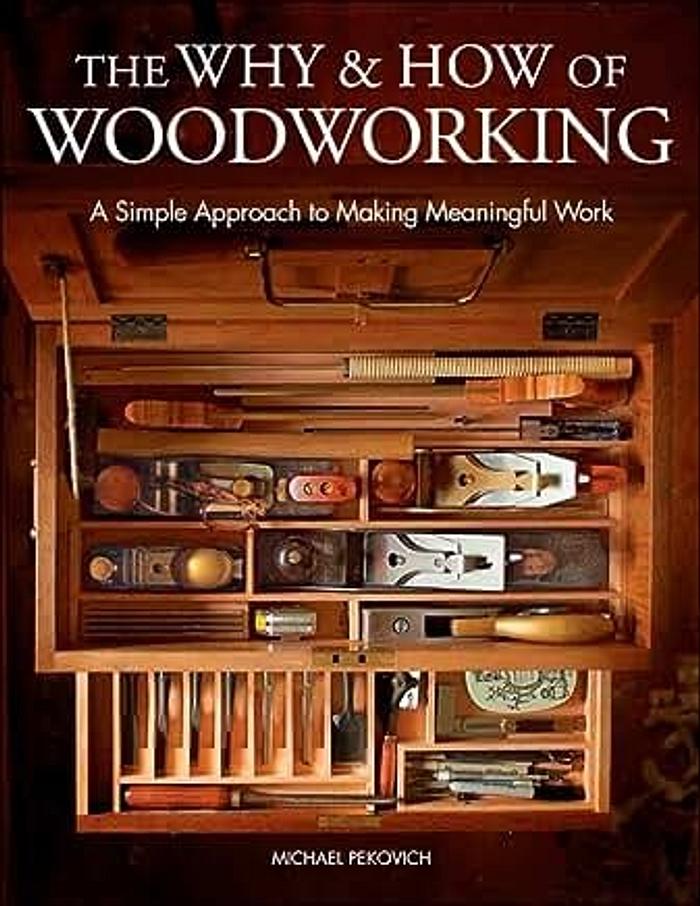Share your craft projects
Make new craft buddies
Ask craft questions
Blog your craft journey

gdaveg
562 posts
and
21 followers
in about 3 years
in about 3 years
Book Review Mike Pekovich Book
The How And Why of Woodworking
(Published 2018)
“The Why and How of Woodworking” is Mike Pekovich’s woodworking book prior to “Foundations of Woodworking”. I really like Mike’s writing style & design.
I read the book reviews on the Amazon site prior to buying it.
I tend to read the 1 star reviews before the 5-star ones, not sure why. The 1 & 2 star reviews were few; 8 out of over 700. One reviewer called the book “preachy” and another reviewer critical of his use of Kumiko panels on many of the projects in this book. There are always naysayers.
I tend to read the 1 star reviews before the 5-star ones, not sure why. The 1 & 2 star reviews were few; 8 out of over 700. One reviewer called the book “preachy” and another reviewer critical of his use of Kumiko panels on many of the projects in this book. There are always naysayers.
One of the 3 star reviewers said “could have used less Zen and more sawdust, but overall I loved the book.” That made me chuckle and sealed the deal and ordered it, and am not sorry in the least.
Chapter 1: Making Shop Time Matter
This chapter discussed several things, making shop time a habit, take time to think
This chapter discussed several things, making shop time a habit, take time to think
through the next steps and potentially out beyond them.
I used to fully draw out the project prior to starting, sometimes leaving difficult items till later. Have often been guilty of the “need” to cut boards and telling myself you should really finish figuring out the design.
The little things are often big things is a section Mike devoted time to. Emphasis was put on sharpening tools, tuning up machines and a clean work area. A personal area needing work on, keeping my work area clean.
Rethinking perfection & don’t rush but don’t stand still were two areas that were read quickly. There will be errors in most projects, and finding a tempo that suits you can lead to more satisfying time in the shop were points he made.
Ok, Chapter 1 had a lot of Zen in it. A brief capsule of the remaining chapters follow
Design:
Start with small sketches and refine ideas, learn to trust your eye. You probably have an idea of how big it needs to be. Draw the project to scale.
Mike has several of his design ideas scattered throughout the book. In the cabinet chapter he makes the case for offsets, even small, calling that section “A Study in 1/16’s”. They disguise wood movements due to seasonal moisture changes. This element is a feature of arts and crafts furniture design.
daveg, SW Washington & AZ
5 Comments
I am copy pasting the rest of my review in comments.
Hand Skills:
Hand Skills:
Mike loves doing his joinery by hand but is not opposed to using power tools to help out. He goes over each of what he consider in the “12 Essential Hand Tools”. Of his essentials which I use are squares, chisels, card scrapers, shoulder & block planes.
The sharpening section was one I paid attention to, hating dull tools.
Cabinets:
Mike teaches a class on cabinet building each year. In this chapter Mike presents several small wall cabinet builds which have been class projects. One has dimensions and he goes through the build.
A second small cabinet he added Kumiko panels as a design element. The basic dimensions are shown but the essence of this section is the build of a Kumiko panel and how to make the bevel block’s used in the process.
One our forum members, Eric-The Loft; built the bevel blocks / jigs for fabricating his Kumiko panels.
Boxes and Chests:
Boxes are often one of the first projects a new wood worker attempts. Their size does not intimidate us and costs are usually low, your scrap pile often has the material to construct them.
Mike shows a sled for building mitered boxes. It has hold downs and flip stops that ride on a T-Track.
His “Quick to Make Box” has the design elements Kumiko panel tops, splined corners and building techniques of sawn off lid and my favorite, masking tape to hold mitered box sides together during glue up.
Other boxes included a Tea Box and one with a single sliding door that exposes walnut drawers on one side, slide it over voila white oak drawers on the other.
He covers the build of a Tea Chest with a sliding door with (of course) a Kumiko panel.
Casework:
I especially enjoyed two of Mike’s several projects presented in this chapter, a Low Dresser and a Cabinet on Stand.
daveg, SW Washington & AZ
The Low Dresser had some interesting design features such as the top rails are joined to the legs via a Bridle Joint. He cut out some weight by utilizing frame and panel construction.
The Cabinet on Stand was a trademark of James Krenov a builder that inspired Mike during his college years. The cabinet slightly floats above the stand.
Both these projects are well dimensioned.
Tables:
The table I found most interesting was his “Dinner Table”. This is another A & C project loaded with details. Bridle Joints on a bias and a “Hay Rake” stretcher stand out to me. When you get to page through this book flip to Chapter 7.
Finishing:
I always look at the section on Finishing first in books and woodworking mags. Mike’s go to finishes are two of my favorites Shellac & Waterlox. He goes through his technique for both.
During my re-read of this book to write this report I grew to appreciate it more and more. There are some ideas worth taking for each reader.
daveg, SW Washington & AZ
I was having issues with getting the site to accept my file. My computer knowledge is limited.
I hope you enjoy this review however unconventional it is.
Dave
I hope you enjoy this review however unconventional it is.
Dave
daveg, SW Washington & AZ
Nice job on the review Dave
Petey
Pekovich is one of my favorite woodworkers that publishes articles and books. A great writeup Dave 👍










